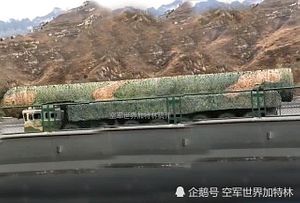China’s DF-41 intercontinental-range ballistic missile (ICBM) has been a subject of Western analyst scrutiny for years now, despite having never been revealed in a formal context.
That might be about to change later this year. According to the South China Morning Post, the People’s Liberation Army Rocket Force may, for the first time, include the DF-41 in a parade to commemorate the 70th anniversary of China’s founding on October 1 this year.
Citing a “military insider” with apparent knowledge of official Chinese plans, the SCMP reports that “weapon systems such as DF-41 intercontinental ballistic missiles and J-2 submarine-launched ballistic missiles have already been moved to Beijing.”
The DF-41, known to the U.S. intelligence community as the CSS-X-20, is a multiple-warhead-capable, road-mobile, solid-fuel ICBM.
While the parade iteration is likely to appear in an integrated launcher, the U.S. Department of Defense’s 2019 report on Chinese military power noted that “China appears to be considering additional DF-41 launch options, including rail-mobile and silo basing.”
Last year, Catherine Dill, a researcher at the Center for Nonproliferation Studies in Washington, D.C., found an apparent DF-41 silo at China’s Wuzhai missile testing site.
Earlier this summer, open source intelligence analysts were able to spot what appeared to be 18 DF-41 transporter-erector-launchers in Beijing outskirts. The DF-41 appeared to be alongside DF-31AG ICBMs and DF-26 intermediate-range ballistic missiles.
The Chinese government has commemorated significant occasions with military parades. In 2015, the People’s Liberation Army participated in a major parade in Beijing to commemorate the 70th anniversary of Japan’s defeat in the Second World War.
In July 2017, Chinese President Xi Jinping presided over a military parade to mark the 90th anniversary of the founding of the People’s Liberation Army. The parade took place in Zhurihe, the PLA’s largest training base. That parade revealed the DF-31AG, an integrated launcher variant of the solid-fuel DF-31 ICBM.
The DF-41’s formal unveiling at this year’s parade may coincide with its deployment. The official deployment of the missile has been predicted by analysts for years, but has yet to take place.
Many details about the DF-41, including the number of warheads it carries, remain uncertain. China is thought to have turned toward multiple independently targetable reentry vehicle (MIRV) technology on the DF-41 amid concerns about U.S. missile defense.
The revelation of the DF-41 would come amid heightened U.S.-China tensions over trade and other issues. The United States, under the Trump administration, has expressed concerns about the expansion of China’s nuclear forces.
The new ICBM would also be revealed amid calls by the Trump administration for China to submit to trilateral arms control talks with the United States and Russia. China, with some 300 nuclear warheads, has a much smaller force size than the United States and Russia.

































